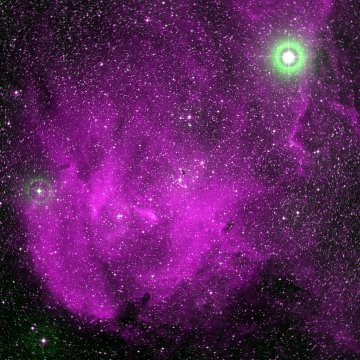RCW 62
Also called
Gum 42, IC 2944, Bran 362aCoordinates: (294.8°, -1.5°)
[ Catalog | Explorer | SIMBAD ]
According to Avedisova, the nebula is ionised by the O6 III giant HD 101190, the O6 V star HD 101436 and the O9 IV subgiant HD 101223 as well as the B0.5 Iab supergiant HD 101545. (SIMBAD gives a much cooler B6Ib/II class for HD 101436.)
A 2013 study finds that the X-ray sources in this direction are concentrated around the O8 V star HD 101205 suggesting that this star may also be associated with the nebula.
Avedisova places RCW 60, RCW 61, RCW 62, Gum 39, Gum 40, Gum 41, Gum 42, and IC 2944 in star formation region SFR 293.64-1.41 with 51 components, including 7 masers and 18 infrared sources. Humphreys says that the hot stars in this direction form the Cru OB1 association at an average distance of 2510 parsecs.
Dutra and colleagues say that RCW 62 contains the infrared group [DBS2003] 69, although curiously they give a distance of only 1700 parsecs.
You can see the spectacular MSX 8μm infrared view here.
Some astronomers misleadingly call this the Lambda Centaurus nebula. Lambda Centaurus is the bright star in the upper right of the image, however, it is a foreground star at a distance of only 63 pc.
Cru OB1 is actually entirely in the constellation Centaurus.[2]
X-rays sources in IC 2944 / 2948 are concentrated around HD 101205. [3]
RCW 62 contains the infrared group [DBS2003] 69. [4]
Notes
1. ^ Grosbol, P. J. (1978). "Space velocities and ages of nearby early-type stars", Astronomy and Astrophysics Supplement Series, Vol. 32, 409-421. [1978A&AS...32..409G]
2. ^ Tovmassian, H. M., Navarro, S. G., & Cardona, O. (1996). "OB Stellar Associations in Crux. II. Analysis and Discussion", The Astronomical Journal, Vol. 111, 306. [1996AJ....111..306T]
3. ^ Nazé, Y., Rauw, G., Sana, H., et al. (2013). "X-ray properties of the young open clusters HM1 and IC 2944/2948", Astronomy and Astrophysics, Vol. 555, A83. [2013A&A...555A..83N]
4. ^ Dutra, C. M., Bica, E., Soares, J., et al. (2003). "New infrared star clusters in the southern Milky Way with 2MASS", Astronomy and Astrophysics, Vol. 400, 533-539. [2003A&A...400..533D]
Links
[ DSS | ADS | ADS Abstract ]
map | book | blog | gallery | sources

This image was created using the POSS-II/UKSTU data of the Digitized Sky Survey and SuperCOSMOS using the process described here.
According to my correspondence with the Royal Observatory Edinburgh and the Space Telescope Science Institute, I am allowed to use the POSS-II/UKSTU data to create and display images for non-commercial purposes so long as I include this fine print for the SuperCOSMOS data:
Use of these images is courtesy of the UK Schmidt Telescope (copyright in which is owned by the Particle Physics and Astronomy Research Council of the UK and the Anglo-Australian Telescope Board) and the Southern Sky Survey as created by the SuperCOSMOS measuring machine and are reproduced here with permission from the Royal Observatory Edinburgh.
and this acknowledgement taken from the DSS site:
The Digitized Sky Surveys were produced at the Space Telescope Science Institute under U.S. Government grant NAG W-2166. The images of these surveys are based on photographic data obtained using the Oschin Schmidt Telescope on Palomar Mountain and the UK Schmidt Telescope. The plates were processed into the present compressed digital form with the permission of these institutions.
The Second Palomar Observatory Sky Survey (POSS-II) was made by the California Institute of Technology with funds from the National Science Foundation, the National Geographic Society, the Sloan Foundation, the Samuel Oschin Foundation, and the Eastman Kodak Corporation.
The UK Schmidt Telescope was operated by the Royal Observatory Edinburgh, with funding from the UK Science and Engineering Research Council (later the UK Particle Physics and Astronomy Research Council), until 1988 June, and thereafter by the Anglo-Australian Observatory. The blue plates of the southern Sky Atlas and its Equatorial Extension (together known as the SERC-J), as well as the Equatorial Red (ER), and the Second Epoch [red] Survey (SES) were all taken with the UK Schmidt.
The "Second Epoch Survey" of the southern sky was made by the Anglo-Australian Observatory (AAO) with the UK Schmidt Telescope. Plates from this survey have been digitized and compressed by the ST ScI. The digitized images are copyright ? 1993-5 by the Anglo-Australian Observatory Board, and are distributed herein by agreement.
The "Equatorial Red Atlas" of the southern sky was made with the UK Schmidt Telescope. Plates from this survey have been digitized and compressed by the ST ScI. The digitized images are copyright ? 1992-5, jointly by the UK SERC/PPARC (Particle Physics and Astronomy Research Council, formerly Science and Engineering Research Council) and the Anglo-Australian Telescope Board, and are distributed herein by agreement.
The compressed files of the "Palomar Observatory - Space Telescope Science Institute Digital Sky Survey" of the northern sky, based on scans of the Second Palomar Sky Survey are copyright ? 1993-1995 by the California Institute of Technology and are distributed herein by agreement. The compressed files of the "Palomar Observatory - Space Telescope Science Institute Digital Sky Survey" of the northern sky, based on scans of the Second Palomar Sky Survey are copyright ? 1993-1995 by the California Institute of Technology and are distributed herein by agreement.